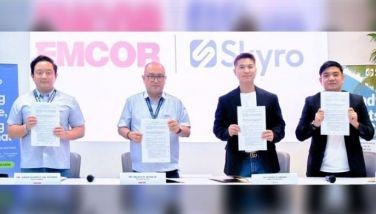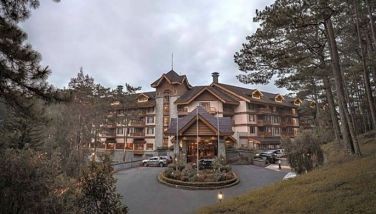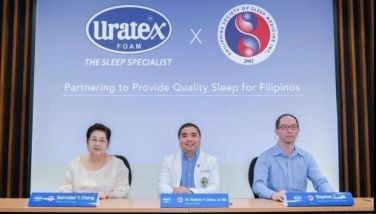Murmurs of the heart: Understanding cardiac risk
February 18, 2002 | 12:00am
It is never too late to have a healthy heart. There are many ways today you can lower your risk factors for heart disease and live a longer life.
That’s the good news from Dr. Fabio Enrique Posas, fellow of the American College of Cardiology and chairman of Cardiovascular Research of St. Luke’s Heart Institute, with expertise in clinical cardiology, cardiac catherization and cardiac and peripheral vascular interventions.
Heart disease, he explains, is not always a disease that occurs as a result of cholesterol plaque causing blockage or narrowing of the arteries that feed blood to the heart – the coronary arteries.
Heart diseases can also be caused by diseases affecting any or all of the four valves of the heart or by muscle disease which may adversely affect the pumping function of the heart.
In fact, even before he talks about prevention of heart disease, Posas prefers to talk about awareness – that you can be healthier for a longer time if you know how to take care of your heart. And step one in that direction is to be able to recognize the risk factors and symptoms of heart disease.
A common symptom is angina pectoris or heart pain which is usually described as exertional heaviness or squeezing chest discomforts. The feeling may spread down one or both arms and also cause choking sensation and shortness of breath. It may occur during exercise, emotional upsets (or even from getting "too happy"), climbing the stairs, anything that increases the workload of the heart. Some individuals may wake up during the night short of breath. The trouble, says Posas, is that people usually never attach this shortness of breath to heart disease.
Another symptom is irregular heartbeat or palpitations. The heart may beat too fast, be irregular or skip beats. People can feel it. Some may lose consciousness, in what is called syncope, or even die. It will be recalled that US Vice President Dick Cheney had life-threatening abnormal rhythms of the heart and had to be implanted with a special pacemaker designed to assist his heartbeat and prevent life-threatening rhythm disturbances.
Then there is the heart attack, which manifests as a severe squeezing or even splitting of the chest, usually lasting some 30 minutes. You feel numbness or tingling down the left arm, shortness of breath, cold and clammy sweat, perhaps loss of consciousness.
Recognition of these symptoms is critical, says Posas, because recovery/survival depends on how fast you can get to the hospital emergency room or your doctor’s office. In essence, the shorter the time from the onset of these symptoms to the time you get medical aid, the greater the chance of survival and of minimizing damage to the heart.
Remember, he cautions, that the muscle which gets infracted or damaged never recovers or regenerates and the pumping of the heart may be significantly impaired.
The key here, he stresses, is recognition and early medical treatment. Your doctor can unblock clogged arteries with clot buster medicines or throbolytics or open the arteries mechanically using balloon angioplasty. In some cases, emergency bypass may be life-saving.
Step 2, therefore, is seeking medical treatment. From your history, and the subsequent use of certain diagnostic procedures, your doctor will be able to determine whether you have a problem, its severity and more importantly, device optimal ways to treat it.
One may have to undergo electrocardiograms, cardiac ultrasound, stress tests and in certain cases, coronary angiography which is basically inserting long catheters and taking pictures of the heart and the arteries which feed blood to it.
"These are procedures being done today on a daily basis by Filipino physicians in centers like St. Luke’s," explains Posas. "It’s not rocket science anymore. These technologies have been around for a long time and do not entail any onerous invasive risk. Most importantly, these procedures allow doctors to tailor specific therapy for the patient which should improve his or her chance of living longer and having useful lives."
New technologies and discoveries have increased ways of improving the functions of the heart and assuring continuous blood flow into that all-important organ. Catheter-based techniques which are minimally invasive have allowed doctors to restore blood flow through diseased coronary arteries and into blood starved segments of the heart.
The coronary stent, for example, is one such device when placed into blocked arteries helps to hold them open and decreases the chance of re-narrowing (In terms of construction, it’s like an imburnal!" laughs the doctor). While current stents do not stop the re-narrowing of the arteries in all cases, a new generation of stents which deliver special drugs into the site where they are implanted will be available in the Philippines in the near future.
These devices have the potential for curing disease and decreasing the need for open heart surgery. These technologies can also be used to open arteries in the legs or the kidneys and even fixing aneurysms in the aorta without having to perform risky open heart surgery.
The heart bypass is being performed daily and safely by well-trained Filipino surgeons. It prolongs life in patients with severe disease, says Posas. It returns individuals to productivity, assures a good quality of life while minimizing the number of medicines taken in.
More surgeons have successfully performed off-pump or beating-heart bypass and even bypasses with smaller incisions which hold the prospect of eventually lowering the cost of surgery and speeding recovery.
Posas also tells of new medicines in the market which have been shown to effectively reduce the risk of heart disease.
Drugs that lower cholesterol significantly reduce the need for bypass or angioplasty while Angiotensin converting inhibitors not only reduce blood pressure but also lower the risk of heart attacks, strokes and even death.
There are even early research studies, Posas adds, which suggest the transplantation of healthy muscle cells to replace muscle in damaged areas of the heart is possible.
As for high cost of medical treatment, Posas says, "Cost is relative to the risk." How much is your risk? How much are you expected to benefit from a recommended procedure? How much is the cost of taking medicines over a lifetime considering that you still remain at risk? How much is the cost in terms of quality of life, loss of productivity or even possible loss of life?
Seen more rationally in the light of cost-to-benefit ratios, the procedure to diagnose, risk stratify and treat the disease may not be all that expensive. Effective and well-timed medical interventions can solve problems and extend your life.
Based on pathologic data from young American soldiers who died during the war, we know that atherosclerosis or the process that narrow arteries begins in the young and manifests in the older population groups. Thus, prevention must begin at a young age and continue throughout life.
Posas recommends that we learn to critically assess and determine one’s risk for understanding the risk factor that plays a role in the genesis of heart disease. One is genetics. Do you have a family history of heart disease? Do you have any relative who died of heart disease at age of 50-60? If so, you may have a genetic predisposition. Second is diabetes or elevated blood sugars. Third is high blood pressure. Fourth is high cholesterol. Fifth is age which is a risk factor only because heart disease is a degenerative disease.
Like an old car, your body needs general maintenance and will run only if well-maintained. Sixth, cigarette smoking, even second-hand smoking. Seventh is male sex and eighth is sedentary lifestyle. Women rarely develop heart disease before age 55 because of estrogen protection; men, on the other hand, tend to manifest the disease and even die at a younger age. One must remember all these risk factors have synergistic effects and multiply the risk attributable to each of those independent risk factors.
You may not be able to choose your ancestor, but you can modify your risk by changing your lifestyle. Your doctor may assist you by providing you with standard formulas that will allow you to calculate your risk more effectively.
Posas has a last word of advice: "Understanding cardiac risk and recognition of symptoms may save your life and that of your loved ones."
That’s the good news from Dr. Fabio Enrique Posas, fellow of the American College of Cardiology and chairman of Cardiovascular Research of St. Luke’s Heart Institute, with expertise in clinical cardiology, cardiac catherization and cardiac and peripheral vascular interventions.
Heart disease, he explains, is not always a disease that occurs as a result of cholesterol plaque causing blockage or narrowing of the arteries that feed blood to the heart – the coronary arteries.
Heart diseases can also be caused by diseases affecting any or all of the four valves of the heart or by muscle disease which may adversely affect the pumping function of the heart.
In fact, even before he talks about prevention of heart disease, Posas prefers to talk about awareness – that you can be healthier for a longer time if you know how to take care of your heart. And step one in that direction is to be able to recognize the risk factors and symptoms of heart disease.
Another symptom is irregular heartbeat or palpitations. The heart may beat too fast, be irregular or skip beats. People can feel it. Some may lose consciousness, in what is called syncope, or even die. It will be recalled that US Vice President Dick Cheney had life-threatening abnormal rhythms of the heart and had to be implanted with a special pacemaker designed to assist his heartbeat and prevent life-threatening rhythm disturbances.
Then there is the heart attack, which manifests as a severe squeezing or even splitting of the chest, usually lasting some 30 minutes. You feel numbness or tingling down the left arm, shortness of breath, cold and clammy sweat, perhaps loss of consciousness.
Recognition of these symptoms is critical, says Posas, because recovery/survival depends on how fast you can get to the hospital emergency room or your doctor’s office. In essence, the shorter the time from the onset of these symptoms to the time you get medical aid, the greater the chance of survival and of minimizing damage to the heart.
Remember, he cautions, that the muscle which gets infracted or damaged never recovers or regenerates and the pumping of the heart may be significantly impaired.
Step 2, therefore, is seeking medical treatment. From your history, and the subsequent use of certain diagnostic procedures, your doctor will be able to determine whether you have a problem, its severity and more importantly, device optimal ways to treat it.
One may have to undergo electrocardiograms, cardiac ultrasound, stress tests and in certain cases, coronary angiography which is basically inserting long catheters and taking pictures of the heart and the arteries which feed blood to it.
"These are procedures being done today on a daily basis by Filipino physicians in centers like St. Luke’s," explains Posas. "It’s not rocket science anymore. These technologies have been around for a long time and do not entail any onerous invasive risk. Most importantly, these procedures allow doctors to tailor specific therapy for the patient which should improve his or her chance of living longer and having useful lives."
New technologies and discoveries have increased ways of improving the functions of the heart and assuring continuous blood flow into that all-important organ. Catheter-based techniques which are minimally invasive have allowed doctors to restore blood flow through diseased coronary arteries and into blood starved segments of the heart.
The coronary stent, for example, is one such device when placed into blocked arteries helps to hold them open and decreases the chance of re-narrowing (In terms of construction, it’s like an imburnal!" laughs the doctor). While current stents do not stop the re-narrowing of the arteries in all cases, a new generation of stents which deliver special drugs into the site where they are implanted will be available in the Philippines in the near future.
The heart bypass is being performed daily and safely by well-trained Filipino surgeons. It prolongs life in patients with severe disease, says Posas. It returns individuals to productivity, assures a good quality of life while minimizing the number of medicines taken in.
More surgeons have successfully performed off-pump or beating-heart bypass and even bypasses with smaller incisions which hold the prospect of eventually lowering the cost of surgery and speeding recovery.
Posas also tells of new medicines in the market which have been shown to effectively reduce the risk of heart disease.
Drugs that lower cholesterol significantly reduce the need for bypass or angioplasty while Angiotensin converting inhibitors not only reduce blood pressure but also lower the risk of heart attacks, strokes and even death.
There are even early research studies, Posas adds, which suggest the transplantation of healthy muscle cells to replace muscle in damaged areas of the heart is possible.
As for high cost of medical treatment, Posas says, "Cost is relative to the risk." How much is your risk? How much are you expected to benefit from a recommended procedure? How much is the cost of taking medicines over a lifetime considering that you still remain at risk? How much is the cost in terms of quality of life, loss of productivity or even possible loss of life?
Seen more rationally in the light of cost-to-benefit ratios, the procedure to diagnose, risk stratify and treat the disease may not be all that expensive. Effective and well-timed medical interventions can solve problems and extend your life.
Based on pathologic data from young American soldiers who died during the war, we know that atherosclerosis or the process that narrow arteries begins in the young and manifests in the older population groups. Thus, prevention must begin at a young age and continue throughout life.
Like an old car, your body needs general maintenance and will run only if well-maintained. Sixth, cigarette smoking, even second-hand smoking. Seventh is male sex and eighth is sedentary lifestyle. Women rarely develop heart disease before age 55 because of estrogen protection; men, on the other hand, tend to manifest the disease and even die at a younger age. One must remember all these risk factors have synergistic effects and multiply the risk attributable to each of those independent risk factors.
You may not be able to choose your ancestor, but you can modify your risk by changing your lifestyle. Your doctor may assist you by providing you with standard formulas that will allow you to calculate your risk more effectively.
Posas has a last word of advice: "Understanding cardiac risk and recognition of symptoms may save your life and that of your loved ones."
BrandSpace Articles
<
>
- Latest
Latest
Latest
October 25, 2024 - 9:00am
October 25, 2024 - 9:00am
October 24, 2024 - 11:20am
October 24, 2024 - 11:20am
October 14, 2024 - 11:00am
October 14, 2024 - 11:00am
October 11, 2024 - 12:49pm
October 11, 2024 - 12:49pm
September 30, 2024 - 8:00am
September 30, 2024 - 8:00am
September 26, 2024 - 2:00pm
September 26, 2024 - 2:00pm
Recommended





























